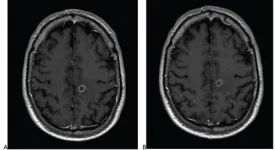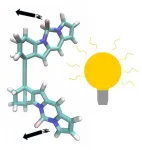(Press-News.org) If the genome is the recipe of life, base pairs are the individual ingredients listed. These chemical structures form DNA, and every living organism on Earth has just four. The specific arrangements of these four base pairs -- A, T, C, G -- make us who and what we are.
So it was a big surprise when Scripps Research scientists revealed in 2014 that they could introduce two new, unnatural base pairs (they called them X and Y for short) into the genetic code of living bacteria in the lab. It was like two never-seen-before ingredients tossed into the recipe, hypothetically expanding the variety of dishes a cell can whip up.
Researchers immediately saw the potential applications: With more control and selection, they might be able to use cells as tiny kitchens to cook up new medicines and vaccines. But just because there are more letters in a genetic recipe doesn't mean the cell can read them, or knows what to do with them -- or that any of it works in the cells of organisms more complicated than bacteria.
In a study published June 17, 2021 in Nature Chemical Biology, a team led by researchers at Skaggs School of Pharmacy and Pharmaceutical Sciences at University of California San Diego helped address these hurdles.
The team revealed that yeast cell machinery seamlessly "reads" the unnatural X and Y ingredients, the way it would A, C, T and G, and translates them into RNA, which could eventually be translated into proteins, the basis for just about every part of the cell. Unlike bacteria, yeast are eukaryotes, part of the same multicellular class of life as animals, plants and fungi. (A note about safety: These synthetic cells can't survive without special liquid food provided in the lab.)
"Now we can see exactly how eukaryotic cell machinery interacts with unnatural base pairs, but it's not perfect, there's room to improve in terms of selectivity and efficiency," said senior author Dong Wang, PhD, professor in the Skaggs School of Pharmacy. "It's our hope that this finding will have a profound impact in the field by enabling the design of more effective, next-generation unnatural base pairs."
Wang's lab has long studied RNA polymerase II, an essential enzyme found in every fungal, plant and animal cell. RNA Pol II reads the DNA recipe and helps convert the genetic code into messenger RNA. (That mRNA then carries that genetic recipe out of the nucleus and into the cytoplasm, where it's translated and used to assemble proteins as instructed.) In the past, the team has studied the structure of RNA Pol II and how it responds to normal genetic recipe hiccups such as DNA damage caused by radiation.
In their latest study, Wang's team revealed for the first time step-by-step what it looks like, structurally speaking, when eukaryotic RNA Pol II picks up and incorporates unnatural base pairs as it transcribes a piece of DNA. In doing so, they discovered, for example, that RNA Pol II is selective -- it can bind X or Y on one strand of a double-stranded DNA genome, but not the other.
"What we have now is a unique view of what is and what is not well recognized by RNA Pol II," said Wang, who is also professor at UC San Diego School of Medicine and Department of Chemistry and Biochemistry. "This knowledge is important for us to design new unnatural base pairs that can be used by host RNA polymerases."
INFORMATION:
Co-authors of the study include: Juntaek Oh, Ji Shin, Wei Wang, Liang Xu, Jun Xu, Jenny Chong, UC San Diego; Ilona Christy Unarta, Xuhui Huang, Hong Kong University of Science and Technology; Aaron W. Feldman, Rebekah J. Karadeema, Ramanarayanan Krishnamurthy, Scripps Research; Floyd E. Romesberg, Synthorx.
In a bid to find or refine laboratory research models for cancer that better compare with what happens in living people, Johns Hopkins Medicine scientists report they have developed a new computer-based technique showing that human cancer cells grown in culture dishes are the least genetically similar to their human sources.
The finding, they say, should help focus more resources on cancer research models such as genetically engineered mice and 3D balls of human tissue known as "tumoroids" to better evaluate human cancer biology and treatments, and the genetic errors ...
An algorithm designed by researchers from Carnegie Mellon University's Computational Biology Department and St. Petersburg State University in Russia could help scientists identify unknown molecules. The algorithm, called MolDiscovery, uses mass spectrometry data from molecules to predict the identity of unknown substances, telling scientists early in their research whether they have stumbled on something new or merely rediscovered something already known.
This development could save time and money in the search for new naturally occurring products that could be used in medicine.
"Scientists waste a lot of time isolating molecules that are already known, essentially rediscovering penicillin," said Hosein Mohimani, an assistant ...
Leesburg, VA, June 17, 2021--According to ARRS' American Journal of Roentgenology (AJR), a reduced dose of gadobutrol is non-inferior to 100%-standard dose of gadoterate for contrast-enhanced brain MRI.
"A 25% reduced gadobutrol dose demonstrated non-inferior efficacy versus standard dose gadoterate for contrast-enhanced brain MRI," corresponding author Jan Endrikat of Germany's University Medical School of Saarland elaborated, "warranting particular consideration in patients undergoing multiple contrast-enhanced examinations."
In this international, prospective, multicenter, open-label, crossover trial (LEADER-75), 141 patients (78 men, 63 women; mean age, 58.5 years) with known or suspected CNS pathology ...
Type 1 diabetes is a disorder in which the immune system inappropriately targets a class of cells in the pancreas known as β cells that produce the hormone insulin, which plays an important role in regulating bloodstream glucose levels and the metabolism of carbohydrates, lipids, and proteins. The loss of insulin causes a range of health problems for people with type 1 diabetes, and patients become dependent on insulin injections for their survival. Even with insulin therapy, people with type 1 diabetes have shortened lifespans and are at an elevated risk of developing myriad complications.
Previous studies have identified numerous genetic risk factors for type 1 diabetes. One notable finding is the importance of the HLA region, a part of the human ...
New technologies allow users to do things like race their real bikes against other real people in a virtual world, and a new study outlines what motivates people to use these online platforms. The findings offer insights for future iterations of these technologies - and how to market them.
At issue are "mixed-reality sports": augmented reality platforms that incorporate virtual, online elements and real-world athletic endeavors. For example, Zwift is a platform that allows users to ride their real bicycles, but transfers their efforts to a virtual space depicting real-world courses - allowing them to race against other cyclists who are not physically present.
"We ...
Medical guidelines help doctors understand the best way to treat health conditions. Surprisingly, many doctors do not adhere to them, and this is a problem, according to a new study by scientists at University of Utah Health and MDGuidelines. People with lower back pain injury miss 11 more days of work in a year when they only receive treatments for lower back pain that are not recommended by medical guidelines compared to people treated according to guidelines. The findings publish in END ...
Light-driven molecular motors have been around for over twenty years. These motors typically take microseconds to nanoseconds for one revolution. Thomas Jansen, associate professor of physics at the University of Groningen, and Master's student Atreya Majumdar have now designed an even faster molecular motor. The new design is driven by light only and can make a full turn in picoseconds, using the power of a single photon. Jansen: 'We have developed a new out-of-the-box design for a motor molecule that is much faster.' The design was published in The Journal of Physical Chemistry ...
When astronomers using NASA's Hubble Space Telescope uncovered an oddball galaxy that looked like it didn't have much dark matter, some thought the finding was hard to believe and looked for a simpler explanation.
Dark matter, after all, is the invisible glue that makes up the bulk of the universe's matter. All galaxies appear to be dominated by it; in fact, galaxies are thought to form inside immense halos of dark matter.
So, finding a galaxy lacking the invisible stuff is an extraordinary claim that challenges conventional wisdom. It would have the potential to upset theories of galaxy formation and evolution.
To bolster their original finding, first reported in 2018 ...
The intestinal disease necrotizing enterocolitis is a leading cause of death among premature infants born in the U.S. and across the globe. Characterized by excessive inflammation that can cause tissue decay in the bowels, the disease provides a pathway for infectious and deadly bacteria to enter the bloodstream.
Despite four decades of research, effective treatments remain elusive, and mortality rates in babies who develop the disease have remained essentially unchanged, hovering at about 30%.
Now, a study led by researchers at Washington University ...
Personalised coaching through a smartphone platform can help women improve their lifestyle behaviours in the period before and shortly after they become pregnant, a new study has shown. The biggest reduction in behaviours that pose risks to pregnancy were seen in overweight women.
The findings, published in the journal Reproductive Biomedicine Online, show that digital healthcare could be a cost-effective way to deliver tailored advice to women who experience difficulties in pregnancy, which the NHS does not have the resources to provide.
In this study, led by the University of Southampton, 262 women who were planning pregnancies and had either experienced difficulties in conceiving or recurrent miscarriages signed ...



